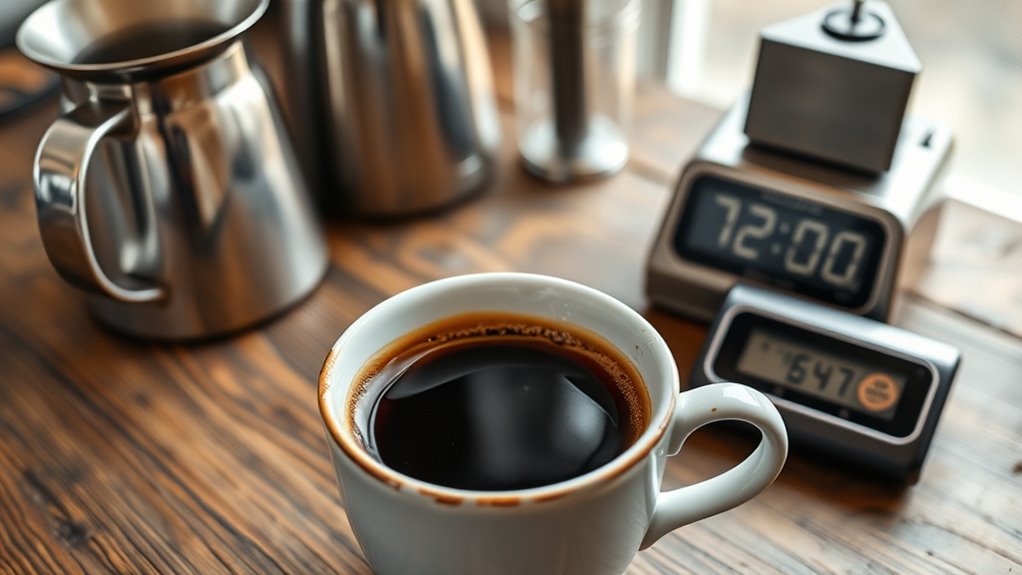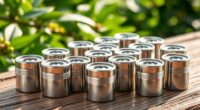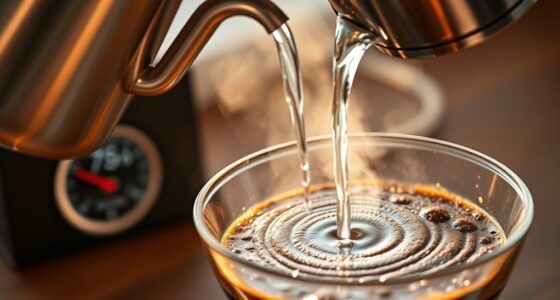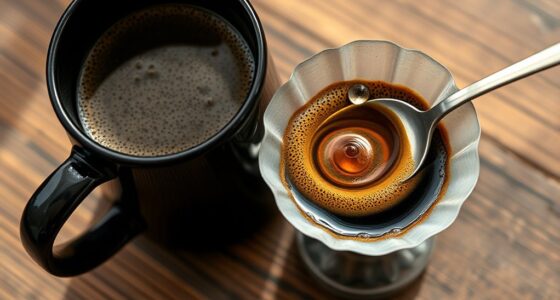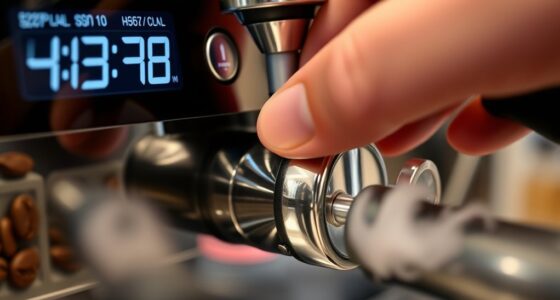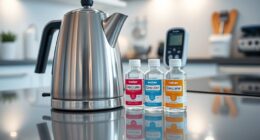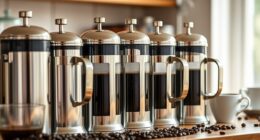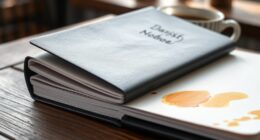If you want great espresso at home, avoid common mistakes like using poor equipment or neglecting maintenance, which can cause off-flavors. Make sure you grind your beans correctly; too fine or coarse affects the taste. Don’t overlook water quality and temperature, both vital for flavor. Practice proper tamping with even pressure, and don’t rush the extraction process. Keep these tips in mind, and you’ll discover how to perfect your brew every time.
Key Takeaways
- Using unmaintained or low-quality equipment causes inconsistent espresso and shortens machine lifespan.
- Incorrect grind size, either too coarse or fine, leads to weak or bitter coffee.
- Poor water quality and temperature control impair flavor and can damage your machine.
- Uneven tamping creates channeling, resulting in uneven extraction and flavor issues.
- Rushing the extraction process prevents proper flavor development and affects overall taste.
Using the Wrong Equipment or Not Maintaining It
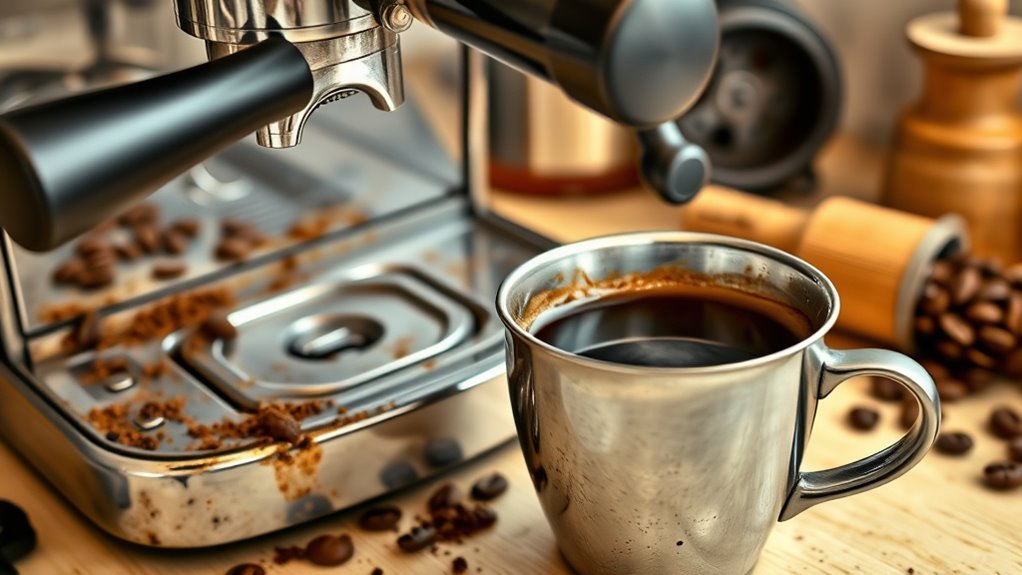
Using the wrong equipment or neglecting proper maintenance can substantially impact the quality of your espresso. Regular maintenance routines are essential to keep your machine in top shape. This includes cleaning group heads, descaling, and replacing worn parts. Skipping these steps can lead to off-flavors and inconsistent extraction. Equipment calibration is equally important; a poorly calibrated grinder or espresso machine will produce uneven grounds and improper pressure, ruining your shot. Invest in quality equipment suited for home use, and follow a routine to maintain it. Proper calibration ensures your machine operates at peak settings, giving you consistent, flavorful espresso every time. Remember, well-maintained, correctly calibrated equipment is key to achieving barista-quality results at home. Properly maintaining espresso machine components helps prevent performance issues and prolongs the lifespan of your equipment, especially when considering home theater projectors and their delicate calibration needs. Additionally, incorporating regular descaling can prevent mineral buildup that affects machine performance.
Incorrectly Grinding Your Coffee Beans

Grinding your coffee beans to the wrong size can severely affect your espresso’s flavor and extraction. If the grind is too coarse, water flows too quickly, resulting in weak, under-extracted coffee. Too fine, and you risk over-extraction, causing bitterness. The grind size should match your bean freshness; fresher beans often need a slightly coarser grind to prevent clogging. Here’s a quick comparison:
| Grind Size | Effect on Espresso |
|---|---|
| Coarse | Weak, under-extracted, watery |
| Medium-coarse | Balanced, smooth extraction |
| Medium | Ideal for espresso, consistent taste |
| Fine | Over-extracted, bitter |
| Extra-fine | Likely to clog, difficult to extract |
Getting the grind size right ensures ideal flavor, especially since fresh beans can be more sensitive to grind adjustments. Additionally, considering the extraction process can help you fine-tune your grind for optimal results. Using a quality burr grinder can improve consistency and help you achieve the perfect grind size for your espresso. Proper grind calibration is essential for maintaining a consistent brewing experience and achieving that rich, balanced shot every time. Moreover, understanding the layer concepts involved in extraction can help optimize your brewing technique.
Overlooking Water Quality and Temperature

Water quality and temperature are critical factors often overlooked but essential for brewing a perfect espresso. Water purity directly impacts flavor; impurities or minerals can cause off-tastes or clog your machine. Using filtered or bottled water ensures cleaner, more consistent results. AI-driven monitoring technology can help you track water quality and temperature more precisely, ensuring optimal brewing conditions. Additionally, understanding the integration of AI in mobile devices can provide insights into how technology can assist in maintaining consistent brewing parameters. Temperature control is equally important—water that’s too hot or too cold affects extraction. Ideally, your water should be around 195°F to 205°F for ideal extraction. If your machine lacks precise temperature control, it’s worth investing in a thermometer or upgrading your equipment. Consistently monitoring water quality and maintaining proper temperature helps you achieve balanced, flavorful espresso. Proper water quality directly influences extraction and taste, so neglecting it can lead to flat or bitter shots, wasting your effort and coffee. Focus on water quality and temperature control to elevate your home espresso game.
Not Tamping Properly or Applying Uneven Pressure

Even if your water quality and temperature are spot-on, uneven tamping can sabotage your espresso. Your tamping technique is vital for achieving the right extraction, and inconsistent pressure can lead to under- or over-extraction. To prevent this, apply firm, even pressure across the coffee bed, ensuring the surface is level. Using a tamper with a flat bottom helps distribute pressure uniformly, promoting pressure consistency throughout. Avoid rushing or pressing unevenly, as this can cause channeling and uneven extraction. Practice your tamping until it feels natural and consistent, and always check that the coffee surface is smooth and level before brewing. Proper tamping is a simple step that makes a significant difference in the quality of your home espresso. Incorporating consistent tamping technique into your routine can also help maintain your coffee’s optimal extraction and flavor. Paying attention to tamping pressure can make a noticeable difference in achieving the perfect shot. Additionally, understanding the importance of coffee grind size can further enhance your results.
Rushing the Extraction Process

Rushing the extraction process can severely compromise the flavor and consistency of your espresso. When you hurry, you often sacrifice timing precision, which is essential for a balanced shot. Proper extraction requires letting the coffee brew for the right amount of time; too short or too long can result in sour or bitter flavors. Additionally, pressure control plays a critical role—if you don’t maintain consistent pressure throughout, the espresso may taste flat or uneven. Take your time to monitor your extraction closely, ensuring your machine’s pressure is steady and your timing is accurate. This patience allows the coffee to develop its full depth of flavor, delivering a rich, smooth shot every time. Rushing only leads to subpar results and missed opportunities for a perfect espresso. Ensuring your brewing time aligns with recommended standard bank hours can help you set aside dedicated time for proper preparation and consistent brewing techniques.
Frequently Asked Questions
How Often Should I Clean My Espresso Machine?
You should clean your espresso machine after every use to maintain milk frothing quality and guarantee bean freshness. Regular cleaning prevents buildup of milk residue and coffee oils that can affect flavor. Deep clean weekly with descaling solutions, especially if you notice scale or reduced performance. Proper maintenance keeps your machine running smoothly, preserves the taste of your espresso, and extends its lifespan, making every shot as good as the first.
What Size Grind Is Best for Espresso?
For the best espresso, aim for a fine, consistent grind. Your burr grinder type matters—conical burrs often produce more uniform particles than flat burrs. Consistent grind size guarantees proper extraction, so avoid changing your grind too often. A fine grind, similar to powdered sugar, helps achieve the rich, bold flavor you want. Remember, maintaining grind consistency is key to making great espresso at home.
How Does Water Hardness Affect My Espresso?
Water hardness, influenced by water mineral content like calcium, directly impacts your espresso. Hard water with high calcium buildup can cause mineral deposits in your machine, affecting temperature stability and extraction quality. To improve your espresso, use filtered or soft water to reduce mineral content. This prevents calcium buildup, ensuring consistent flavor and prolonging your machine’s lifespan, so you get the best shot every time.
What’s the Ideal Tamping Pressure for a Perfect Shot?
Think of tamping pressure like finding the sweet spot—you want about 30 pounds of force for a perfect shot. Too much or too little can throw things off, so keep your tamping consistent. Make sure your grinder calibration is spot-on, giving you a uniform grind. This way, your tamping pressure will be effective, and you’ll enjoy rich, balanced espresso every time. Practice makes perfect, so stay persistent!
How Long Should the Extraction Process Take?
You should aim for an extraction time of about 25-30 seconds to get the best flavor. Keep your brew temperature steady and maintain pressure consistency throughout the process. If the shot pulls too quickly, your coffee may be weak; too slow, and it could be bitter. Adjust your tamping pressure and grind size as needed to achieve that ideal extraction window, ensuring a rich, balanced espresso every time.
Conclusion
By avoiding these common mistakes, you’ll craft a perfect espresso every time—no need to wait for a barista’s magic. Think of your kitchen as your own little coffee shop, where every shot counts. With a little patience and attention to detail, your mornings will feel as smooth as a vintage vinyl record spinning on your turntable. So, take these tips to heart, and soon you’ll be brewing espresso that rivals even the finest cafés.
